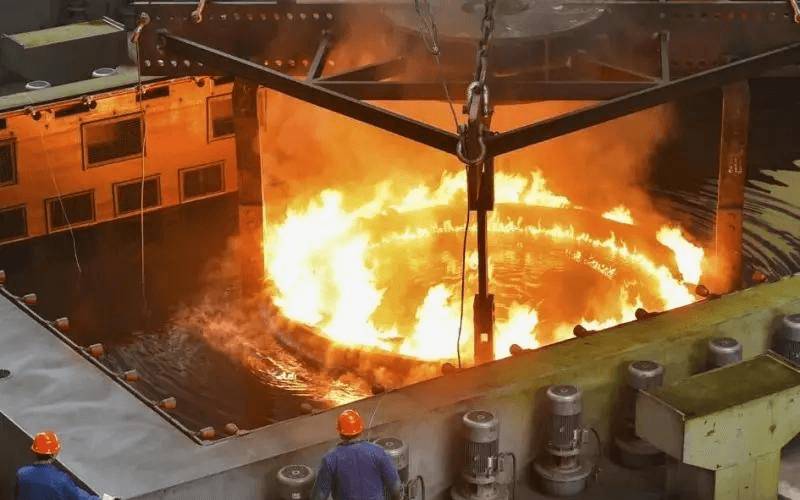Quenching and tempering treatment: The heat treatment method of high-temperature tempering after quenching is called quenching and tempering treatment. High-temperature tempering refers to tempering between 500-650 °C. Quenching and tempering can greatly adjust the properties and materials of steel, and its strength, plasticity, and toughness are good, and it has good comprehensive mechanical properties.
After quenching and tempering treatment, tempered sorbite is obtained. Tempered sorbite is formed when martensite is tempered, and can only be distinguished by magnifying 500-600 times under an optical metallographic microscope. carbon body) composite organization of spherulites. It is also a tempered structure of martensite, which is a mixture of ferrite and granular carbide. At this time, the ferrite has no carbon supersaturation, and the carbide is also a stable carbide, which is a balanced structure at room temperature.
Quenched and tempered steel has two categories: carbon quenched and tempered steel and alloy quenched and tempered steel. Whether it is carbon steel or alloy steel, its carbon content is strictly controlled. If the carbon content is too high, the strength of the workpiece after quenching and tempering is high, but the toughness is not enough. If the carbon content is too low, the toughness is improved and the strength is insufficient. To obtain good comprehensive performance of the quenched and tempered parts, the carbon content is generally controlled at 0.30~0.50%.
Similar Articles:
- Normalizing
- Heat treatment
- Quenching & Tempering
- Normalizing & Annealing
- Quenching and tempering(QT)
- Quenched and tempered steel
- Heat treatment quality inspection
- Heat treatment workshop work instructions
- Explanation of metallographic structure terms
- Factors Affecting Heat Treatment Deformation
- Common heat treatment process of steel castings
Case Studies
Quenching and tempering of 45# steel
45 steel is a medium carbon structural steel with good hot and cold processing properties, good mechanical properties, low price, and wide sources, so it is widely used. Its biggest weakness is low hardenability, and workpieces with large cross-sectional dimensions and relatively high requirements should not be used.
The quenching temperature of 45 steel is A3+(30~50)℃. In actual operation, the upper limit is generally taken. A high quenching temperature can speed up the heating of the workpiece, reduce surface oxidation, and improve work efficiency. To homogenize the austenite of the workpiece, a sufficient holding time is required. If the actual furnace load is large, it is necessary to appropriately extend the holding time. Otherwise, there may be insufficient hardness due to uneven heating. However, if the holding time is too long, there will also be coarse grains and serious oxidative decarburization, which will affect the quenching quality. We believe that if the furnace loading is greater than the requirements of the process document, the heating and holding time should be extended by 1/5.
Because of the low hardenability of 45 steel, a 10% salt solution with a large cooling rate should be used. After the workpiece enters the water, it should be hardened, but not cold through. If the workpiece is cooled in salt water, it may crack the workpiece. This is because when the workpiece is cooled to about 180 °C, the austenite rapidly transforms into martensite. caused by excessive tissue stress. Therefore, when the quenched workpiece is rapidly cooled to this temperature region, a slow cooling method should be adopted. Since it is difficult to grasp the water temperature, it must be operated by experience. When the workpiece in the water stops shaking, it can be cooled by water and air (if it can be oil-cooled, it is better). In addition, the workpiece should be moved and not static when it enters the water and should be moved regularly according to the geometric shape of the workpiece. The static cooling medium and the static workpiece will cause uneven hardness and uneven stress, which will cause the workpiece to deform and even crack.
The hardness of 45 steel quenched and tempered parts after quenching should reach HRC56~59, the possibility of a large cross-section is lower, but not lower than HRC48, otherwise, it means that the workpiece has not been fully quenched, and sorbite or even ferrite may appear in the structure The tissue, through tempering, remains in the matrix and cannot achieve the purpose of tempering.
Recent Articles:
- Casting technical requirements and analysis of common problems of steel castings
- What is the role of Mo in high manganese steel casting production?
- What effect does carbon have on cast steel and iron during smelting?
- Prevention and Analysis of Stainless Steel Casting Defects
- Causes of cracks in steel castings

